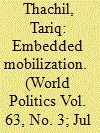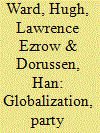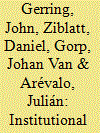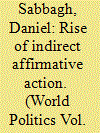| Srl | Item |
| 1 |
ID:
106332


|
|
|
| 2 |
ID:
106335


|
|
|
|
|
| Publication |
2011.
|
| Summary/Abstract |
The authors argue that the effects of economic globalization on social democratic parties in Western Europe are conditional on the position of the median voter. If the median is far enough to the right, such parties will adopt business-friendly policies because they are required to win office. Only when the median is relatively far to the left will globalization constrain social democratic parties, forcing them to adopt policies further to the right in order to retain credibility. It is on this basis the authors argue that empirical studies are misspecified unless they include an interaction between measures of globalization and the position of the median. In addition to presenting formal theoretical arguments, the article reports empirical findings from fifteen countries in the period from 1973 to 2002 that support the conclusion that the effects of globalization are indeed contingent on the median. The authors find that the effects of globalization are significant for social democratic parties only in circumstances in which the median is relatively far to the left.
|
|
|
|
|
|
|
|
|
|
|
|
|
|
|
|
| 3 |
ID:
106331


|
|
|
|
|
| Publication |
2011.
|
| Summary/Abstract |
Most governance arrangements involve spatial units with highly unequal powers, for example, a feudal monarchy and its principalities, an empire and its colonies, a formal empire and an informal empire (or sphere of influence), a national government and its subnational entities, or a regional government and its local entities. In this situation, the dominant unit (A) usually enjoys some discretion about how to institutionalize its authority over the subordinate unit (B). An important element of this decision concerns how much authority should be delegated to the weaker unit. The authors simplify this dimension of governance along a continuum of "direct" and "indirect" styles of rule. Why, in some cases, does one find a relatively direct (centralized) system of rule and in others a relatively indirect (decentralized) system of rule? While many factors impinge on this decision, the authors argue that an important and highly persistent factor is the prior level of centralization existing within the subordinate unit. Greater centralization in B is likely to lead to a more indirect form of rule between A and B, all other things being equal. The authors refer to this as an institutional theory of direct/indirect rule. Empirical analyses of this hypothesis are applied to patterns of direct and indirect rule (1) during the age of imperialism and (2) across contemporary nation-states. The article concludes by discussing applications of the theory in a variety of additional settings.
|
|
|
|
|
|
|
|
|
|
|
|
|
|
|
|
| 4 |
ID:
106334


|
|
|
|
|
| Publication |
2011.
|
| Summary/Abstract |
A growing trend in the comparative politics literature on patterns of minority incorporation emphasizes the emerging policy convergence in this area, conventional oppositions between national models notwithstanding. This convergence is further illustrated by drawing upon the cases of two countries often analyzed within an "exceptionalist" framework and generally viewed as polar opposites as far as the political legitimacy and legal validity of race-based classifications are concerned: the United States and France. The analysis of recent programs designed to increase the "diversity" of the student body in selective institutions of higher education demonstrates that indirectaffirmative action is the instrument around which French and U.S. policies have tended to converge. This increasingly visible convergence obtains in part because of the current move toward color-blindness as a matter of law in the United States. Yet it is also a reflection of the fact that the ultimate purpose of affirmative action in liberal democracies requires a measure of indirection and/or implicitness.
|
|
|
|
|
|
|
|
|
|
|
|
|
|
|
|